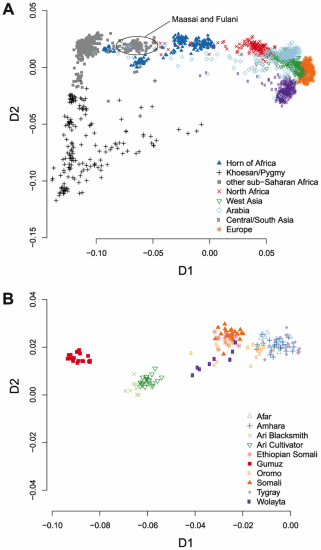Source - http://dienekes.blogspot.fr/2014/06/an-older-layer-of-eurasian-admixture-in.html
The authors propose that a genetic component found in Horn of Africa populations back-migrated to Africa from Eurasia ~23 thousand years ago. I did not read this carefully yet, but it seems reasonably plausible. The migration uncovered by Pagani et al. and Pickrell et al. (~3kya) is probably not the whole story of Eurasian back-migration into Africa; that episode probably involved only Semitic speakers (it's hard to imagine any other language being carried from the Middle East at that time frame). But the Eurasian affiliation of East Africans extends well beyond Semitic speakers. In North Africa this is even clearer as the native (pre-Arab) population is definitely broadly West Eurasian and this must have come about by back-migration.
The back-migration of M1 and U6 into Africa seems to be at a similar time depth as the one proposed by these authors (post-initial UP, but pre-Neolithic). I have proposed that haplogroup E may represent an even earlier layer of Eurasian back-migration, while the signals identified by Pagani et al. and Pickrell et al. in East Africa, Pickrell et al. for Southern Africa, and the limited (but present) Neandertal ancestry in Yoruba and Pygmies documented by Pruefer et al. represent later events. The arrival of Arabs and Europeans are later events still.
For a time, there was a taboo against imagining back-migration into Africa; in a sense this was reasonable on parsimony grounds: Africans have most autosomal genetic diversity and the basal clades of mtDNA and Y-chromosomes; a model with Out-of-Africa is simpler than one with both Out-of and Into-Africa. However, we now know that pretty much all Africans have Eurasian ancestry, ranging from at least traces in theYoruba and Pygmies (to account for the Neandertal admixture) to intermediate values in East Africans, to quite a lot in North Africans.
Eurasian admixture in Africa seems to be general, variable, and to have occurred at different time scales. It's still the best hypothesis that modern humans originated in Africa initially and migrated into Eurasia. However, it is no longer clear that Africa was always the pump and never the destination of human migrations.
PLoS Genet 10(6): e1004393. doi:10.1371/journal.pgen.1004393

Multidimensional scaling analysis shows the great genetic diversity within the Horn of Africa.
We plotted the first two dimensions of a multidimensional scaling analysis of pairwise identity by state across all study populations. (A) The HOA populations are broadly scattered between out-of-African populations and the bulk of sub-Saharan African populations along the first dimension. Some clusters of HOA individuals are much closer to the main sub-Saharan African cluster, while others are much closer to North African and Arabian clusters. (B) In this plot, we zoom in on the HOA samples and leave out all other populations. While the region as a whole covers a broad swath of the first MDS dimension, most individual populations are tightly clumped, with groups separated by language. The Nilo-Saharan speaking Gumuz are on the far left, the Omotic speaking Ari are in the center, and the Cushitic and Semitic speaking populations are on the right.
doi:10.1371/journal.pgen.1004393.g001
Early Back-to-Africa Migration into the Horn of Africa
Jason A. Hodgson
Genetic studies have identified substantial non-African admixture in the Horn of Africa (HOA). In the most recent genomic studies, this non-African ancestry has been attributed to admixture with Middle Eastern populations during the last few thousand years. However, mitochondrial and Y chromosome data are suggestive of earlier episodes of admixture. To investigate this further, we generated new genome-wide SNP data for a Yemeni population sample and merged these new data with published genome-wide genetic data from the HOA and a broad selection of surrounding populations. We used multidimensional scaling and ADMIXTURE methods in an exploratory data analysis to develop hypotheses on admixture and population structure in HOA populations. These analyses suggested that there might be distinct, differentiated African and non-African ancestries in the HOA. After partitioning the SNP data into African and non-African origin chromosome segments, we found support for a distinct African (Ethiopic) ancestry and a distinct non-African (Ethio-Somali) ancestry in HOA populations. The African Ethiopic ancestry is tightly restricted to HOA populations and likely represents an autochthonous HOA population. The non-African ancestry in the HOA, which is primarily attributed to a novel Ethio-Somali inferred ancestry component, is significantly differentiated from all neighboring non-African ancestries in North Africa, the Levant, and Arabia. The Ethio-Somali ancestry is found in all admixed HOA ethnic groups, shows little inter-individual variance within these ethnic groups, is estimated to have diverged from all other non-African ancestries by at least 23 ka, and does not carry the unique Arabian lactase persistence allele that arose about 4 ka. Taking into account published mitochondrial, Y chromosome, paleoclimate, and archaeological data, we find that the time of the Ethio-Somali back-to-Africa migration is most likely pre-agricultural.